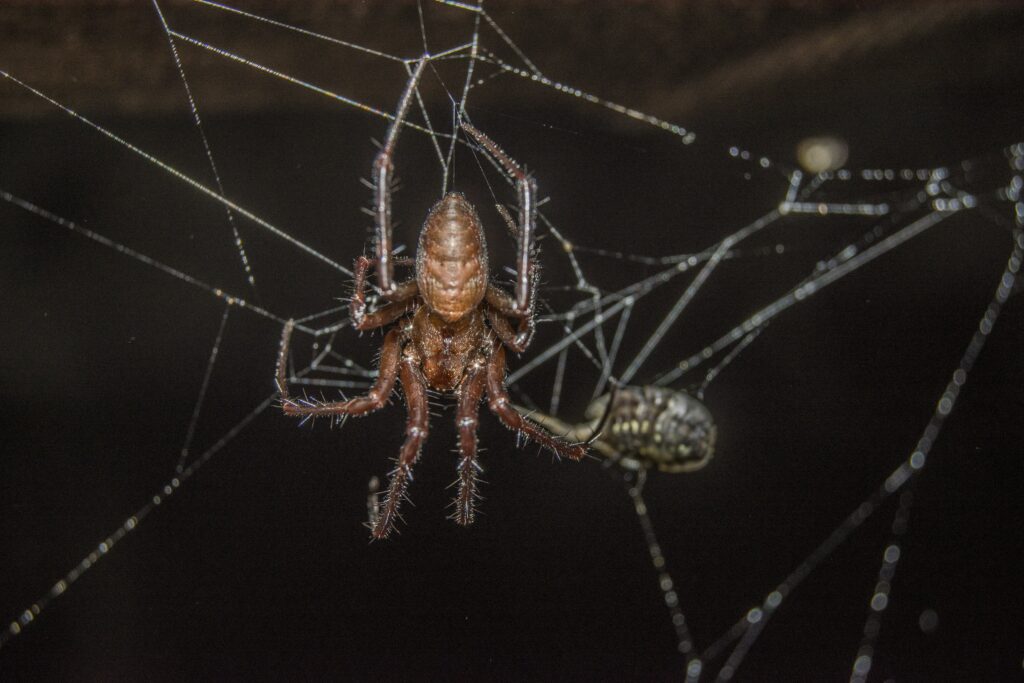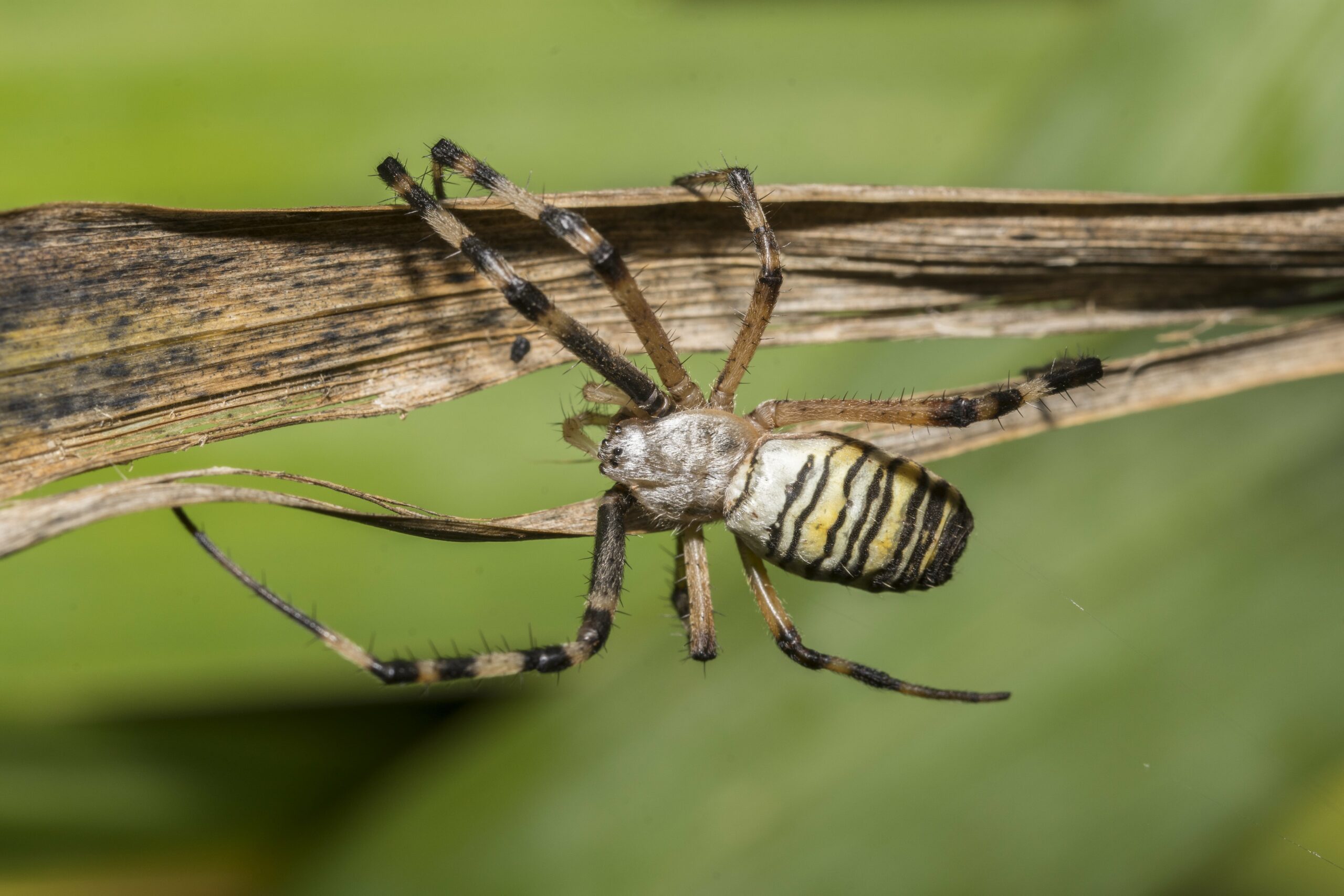A Charming Look into the Lives of Housebound Eight-Legged Wanderers
Ah, grass spiders, those fascinating arachnids that occasionally make their way into our humble abodes. Picture them as nature’s tiny adventurers seeking shelter from the unpredictable elements. These delicate creatures boast a unique set of characteristics that distinguish them from their eight-legged counterparts.
But why would these gentle wanderers venture indoors? Let’s explore the reasons behind their occasional house visits and unravel the mystery behind these captivating critters.
Grass spiders (Agelenopsis spp.), often mistaken for brown recluse spiders due to their similar appearance, possess a remarkable set of features that make them stand out in the spider kingdom. Sporting a light brownish hue, these agile hunters measure around ¼ to ⅜ inches with two dark brownish bands running down their cephalothorax (the fused head and thorax).
Their elongated legs are adorned with fine hairs that assist in navigating through various terrains, including human skin – although they find human skin difficult to navigate smoothly. Now, you may be wondering, what compels these miniature explorers to tour our homes uninvited?
Well, there are several reasons for this peculiar behavior of wolf spiders. Firstly, grass spiders seek refuge from unfavorable weather conditions like heavy rainfall or extreme temperatures.
Our cozy houses provide them with shelter from these harsh elements. Secondly, they may accidentally stumble upon an open door or window while chasing prey or exploring nearby vegetation.
As hunters by nature, these resourceful spiders thrive on an abundant food supply. In our homes leave pet food alone, they can find a smorgasbord of delicacies such as ants, flies, and other pests attracted to food crumbs or pet food left unattended.
The presence of dense vegetation around houses can also lure grass spiders inside as it closely resembles their natural habitat, enticing them to explore further. So, when you spot the occasional grass spider roaming in your living room, remember, their visit is merely driven by a quest for food and a safe haven from the elements.
Understanding these aspects of grass spider behavior is crucial before we delve into effective measures to keep them at bay. Fear not!
We shall embark on this journey together, armed with knowledge and strategies to foster a peaceful coexistence with these spindly guests. Now let us proceed, my fellow enthusiasts of pest management and lovers of all things eight-legged!
Identifying Grass Spiders

The Astonishing Attributes of Grass Spiders
When it comes to identifying grass spiders, their physical appearance and distinctive features make them stand out from other spider species commonly found indoors. These arachnids possess a captivating appearance that can leave even the most ardent entomologists in awe. Measuring around half an inch to an inch in length, female grass spiders exhibit a slim build with elongated legs, granting them a rather elegant look.
Their bodies are usually adorned with subtle patterns and hues ranging from light brown to gray or black. One characteristic that sets grass spiders apart from their eight-legged counterparts is their keen eyesight, thanks to their eight eyes arranged in two rows of four.
This visual acuity allows them to spot potential prey or danger from afar, making them quite formidable hunters. Additionally, these agile creatures possess strong front legs designed for capturing and immobilizing their unsuspecting victims.
Comparing the Grass Spider’s Lair
While grass spiders boast unique traits, it is crucial to differentiate them from other spider species found within our abodes. One common misconception is confusing grass spiders with dangerous or poisonous spiders such as the infamous black widow or brown recluse. However, rest assured that grass spiders are harmless to humans and typically bite only if directly provoked.
In contrast to other indoor spider species that tend to build tangled cobwebs scattered across corners or ceilings (often causing dismay among arachnophobes), grass spiders have a distinct web-building technique. They construct tunnel-like retreats known as the funnel web webs where they patiently await passing prey.
These funnel-shaped webs are usually built near the ground amidst vegetation or structural crevices—spots often frequented by insects—making them ideal hunting grounds for these voracious predators. By understanding the defining characteristics of grass spiders and distinguishing them from other spider species commonly encountered indoors, you can better identify these fascinating arachnids and take appropriate measures to discourage their presence in your home.
Understanding the Behavior of Grass Spiders
Explanation of Grass Spider Habits and Preferred Habitats
Grass spiders, scientifically known as Agelenopsis, are fascinating creatures that have adapted well to a wide range of habitats. However, when it comes to finding shelter indoors, their primary motivation is often the search for food rather than seeking a new home.
These arachnids typically build their funnel-shaped webs in grassy areas around homes or in garden beds. Their preferred habitats include tall grasses, overgrown vegetation, and brush piles, which provide ample hiding spots for them to set up camp.
Insight into Their Hunting Techniques and Prey Preferences

Grass spiders possess remarkable hunting techniques that contribute to their success as predators. Unlike some other spider species that actively hunt down their prey, grass spiders construct intricate webs consisting of a flat sheet and a tunnel-like retreat where they hide while waiting for unsuspecting insects to stumble into their trap. Once caught in the sticky silk threads of the web, the grass spider bites and swiftly immobilizes its prey by injecting venom through its small fangs.
When it comes to prey preferences, grass spiders primarily feed on small insects such as flies, mosquitoes, and gnats. They play a beneficial role in maintaining the ecological balance by controlling populations of these problematic insects.
However, grass spiders are dangerous, it’s important to note that they do not directly target humans or pets as sources of food. So don’t fret—your pet’s food bowl won’t attract hordes of hungry grass spiders.
To discourage grass spiders from entering your home or yard unintentionally during their quest for prey or shelter, it’s vital to maintain good pest management practices both indoors and outdoors. By regularly cleaning up food crumbs and ensuring your lawn is frequently mowed and free from excessive vegetation or brush piles near your house foundation, you can significantly reduce the likelihood of a grass spider infestation.
Prevention Methods to Keep Grass Spiders Out
Sealing entry points: windows, doors, cracks, and gaps
To keep those sneaky grass spiders from invading our cozy abodes, it’s crucial to fortify our defenses by sealing any potential entry points. Start by inspecting your windows for gaps or cracks that might serve as an open invitation for these eight-legged intruders. Consider using weatherstripping or caulking to seal up these vulnerable areas, ensuring a tight barrier against grass spider webs and infiltration.
Don’t forget about doors too! Check the bottom of your doors for any gaps that need sealing with door sweeps or draft stoppers.
Cracks and gaps in walls can also be prime targets for grass spider ingress. Grab a tube of caulk and carefully fill in these crevices, making sure to cover all the nooks and crannies where they could find their way inside.
It’s amazing how something as tiny as a spider can wiggle through the smallest of openings! By diligently addressing these potential entry points, you’ll significantly reduce the chances of unwanted arachnid visitors.
Removing outdoor clutter near the house that may attract spiders

Now that we’ve taken care of fortifying our indoors against grass spiders, let’s turn our attention outdoors. One key step is to clear away any unnecessary outdoor clutter near your house that might serve as an enticing playground for these eight-legged critters.
Tall grasses and dense vegetation around your home create the perfect grass spider habitat by providing them with shelter and camouflage. Start by trimming any tree branches or shrubs touching the exterior walls or roof of your house.
These natural “bridges” can act as highways for spiders seeking a cozy indoor spot. Additionally, remove piles of leaves or other organic debris near entrances; they not only attract insects but also make ideal hiding spots for lurking spiders.
It’s also essential to be mindful of existing lights around your house. While outdoor lighting is undoubtedly useful, it can inadvertently attract insects that, in turn, attract grass spiders seeking an easy meal.
Consider using yellow bug light bulbs or placing exterior lights farther away from entrances to minimize their attractiveness to problematic insects. By paying attention to these outdoor factors, you’ll create a less enticing environment for grass spiders and make your home a less appealing destination for them.
Remember, prevention is key when it comes to keeping grass spiders at bay. Sealing entry points and removing potential attractions outdoors will go a long way in ensuring a spider-free zone within the confines of your humble abode.
Natural Repellents for Grass Spiders
Use of Essential Oils with Strong Scents Disliked by Spiders
When it comes to deterring grass spiders from invading your home, essential oils can be a valuable ally. These oils boast strong scents that spiders find unpleasant, driving them away from your living spaces.
One popular option is peppermint oil, which has a refreshing aroma that humans enjoy but spiders loathe. To apply peppermint oil as a natural repellent, mix around 10-15 drops with water in a spray bottle and generously spritz areas where you’ve noticed spider activity or entry points such as windowsills and door frames.
Peppermint Oil: How to Apply and Its Effectiveness

Peppermint oil is known for its potent scent that acts as an excellent deterrent against grass spiders. Not only does it repel these eight-legged creatures effectively, but it also provides you with the added benefit of freshening up your living space. Remember to shake the peppermint oil and water mixture before each application to ensure an even distribution of the solution’s active compounds.
Apply the spray liberally around potential entry points like cracks or gaps in walls, windowsills, or door frames. The effectiveness of peppermint oil may vary depending on various factors such as spider species present in your area and the extent of the infestation.
While some homeowners report noticeable results within days of using this natural repellent, others may need to reapply it more frequently for optimal outcomes. Additionally, maintaining a clean environment by regularly dusting corners and removing spider webs increases the effectiveness of any treatment method.
Citrus Oils: Lemon, Orange, or Grapefruit as Alternatives

If you want to explore alternatives to peppermint oil or add extra variety to your spider-repelling arsenal, consider using citrus oils such as lemon, orange, or grapefruit. Just like peppermint oil, these citrus-scented oils are disliked by spiders due to their strong aromas.
To harness their repellent properties, mix 10-15 drops of your preferred citrus oil with water in a spray bottle and apply it to areas where you’ve spotted spider activity or potential entry points. Citrus oils not only create an unwelcome environment for grass spiders but also leave behind a pleasant, fresh scent.
They can be particularly effective when used in conjunction with other preventative measures like sealing cracks and eliminating clutter around your home. Remember to reapply the citrus oil solution regularly to maintain its effectiveness, especially if you notice increased spider presence or signs of webs in your living spaces.
Tea Tree Oil: Benefits and Application Methods

Another natural repellent that can help you rid your home of grass spiders is tea tree oil. Known for its potent antimicrobial and insect-repelling properties, tea tree oil can be an excellent addition to your spider control routine.
Mix around 10-15 drops of tea tree oil with water in a spray bottle and apply it directly to areas where spiders are likely to enter or congregate. Tea tree oil not only creates an environment that spiders find uninviting but also serves as a natural disinfectant for your living spaces.
Be cautious when using tea tree oil if you have pets at home as it may be toxic to them if ingested in large quantities. As with any essential oil-based solution, reapplication is key for continued effectiveness.
Remember that while natural repellents like peppermint oil, citrus oils, and tea tree oil can help deter grass spiders from entering your living spaces, they may not eliminate an existing severe grass spider infestation entirely. It’s important to combine these methods with other prevention techniques and regularly monitor the situation to keep those eight-legged intruders at bay successfully.
Chemical-Free Spider Traps for Indoor Use
A Description of Sticky Traps Specifically Designed for Spiders
When it comes to tackling the issue of grass spiders inside your home, one effective and chemical-free method is the use of sticky traps specially designed to catch spiders. These traps are composed of a sticky adhesive surface that lures and attracts grass spiders onto them, effectively immobilizing the pesky arachnids. They work by taking advantage of spiders’ natural instinct to explore surfaces and investigate potential prey or mating opportunities.
These spider traps are typically made with non-toxic materials, making them safe for use in households with children or pets. They come in various sizes and designs, but most consist of a flat piece covered in adhesive material.
Some may even feature a baited lure to attract grass spiders with scents they find enticing. When a spider crawls onto the trap, its tiny hairs get caught on the adhesive surface, preventing it from escaping.
How These Traps Work Effectively Without Harmful Chemicals
The beauty of these sticky traps lies in their simplicity and effectiveness. As grass spiders move around your house in search of prey or mates, they are likely to encounter these traps placed strategically along their usual paths or near potential hiding spots. The sticky surface acts as an irresistible invitation for them to explore further.
Once a grass spider encounters the trap and gets ensnared by the adhesive surface, it becomes trapped without any need for harmful chemicals or toxins. This eliminates any potential risks associated with using pesticides indoors while successfully reducing the population of unwanted grass spiders.
Placement Tips to Maximize Trapping Success
To ensure optimal success when using sticky traps designed for grass spiders, proper placement is key. Consider positioning them near areas where you have noticed high spider activity or where you suspect their entry points might be located.
Common places to consider include corners of rooms, beneath furniture, along baseboards, and anywhere you have seen funnel-like webs or grass spiders themselves. You can also place the traps near windowsills or doorways where spiders may be entering your home.
Remember to avoid placing the traps in areas frequented by children or pets to prevent accidental contact with the adhesive surface. Regularly check the traps and replace them when they become filled with captured spiders or lose their stickiness.
By utilizing these specially designed sticky traps, you can effectively discourage grass spiders from taking up residence in your home without resorting to harmful chemicals. Their simplicity, non-toxic nature, and ability to catch spiders make them an excellent addition to your arsenal of pest control methods.
Professional Pest Control Options
When to consider hiring a pest control expert for severe infestations
Sometimes, despite our best efforts, grass spiders can become more than just an occasional presence in our humble abodes. When their numbers multiply uncontrollably and their webs seem to infiltrate every nook and cranny of our living spaces, it might be time to bring in the cavalry – a professional pest control expert.
While it’s true we can handle minor spider populations on our own, severe infestations may require the expertise and specialized tools of a trained professional. A critical factor to consider is the extent of the infestation.
If you find yourself constantly encountering spiders in every corner of your home or notice an overwhelming number of egg sacs hatching regularly, these are signs that you might be dealing with a severe situation. Additionally, if anyone in your household has experienced adverse reactions due to spider bites or has pre-existing health conditions that make them particularly vulnerable to infections or complications from spider bites, seeking professional help is strongly recommended.
Overview of professional treatment methods available
When enlisting the aid of a pest control expert to combat grass spiders in your house, rest assured they have an arsenal of effective treatment methods at their disposal. One common approach to kill grass spiders is targeted insecticide application.
These professionals are skilled at identifying the areas where spiders are likely to hide and breed, such as dark corners, crawlspaces, basements, or attics. They will apply insecticides specifically formulated for spider eradication in these areas while taking all necessary precautions to ensure the safety and well-being of your household members and pets.
Furthermore, pest control experts often focus on addressing the root cause by implementing comprehensive strategies that go beyond immediate extermination. They aim to disrupt spiders’ habitats by eliminating potential food sources like other insects and removing any debris or clutter that could serve as hiding spots.
By employing integrated pest management techniques, professionals help create a less hospitable environment for spiders to thrive in, reducing the chances of reinfestation. In cases where the infestation is particularly stubborn or widespread, pest control experts may employ advanced methods like fumigation or heat treatment.
These techniques are designed to reach every nook and cranny of your home, ensuring complete eradication of all spider populations. However, it is important to discuss the available treatment options thoroughly with the professionals and understand the potential risks and benefits associated with each method before making a final decision.
Remember, when it comes to tackling severe grass spider infestations, professional pest control companies have both the expertise and resources required to address the problem effectively. Consulting with them can bring peace of mind, knowing that your home will be treated comprehensively and any future reinfestations can be kept at bay with their guidance on preventive measures.
Common Misconceptions about Grass Spiders in Houses
Dispelling myths related to venomous bites or dangerous behavior seems to be a pervasive myth surrounding grass spiders that they are venomous and pose a significant threat to humans. However, it’s time to set the record straight. Grass spiders, scientifically known as Agelenopsis, are not considered dangerous or harmful to people. While it is true that they possess venom glands like most spiders, their venom is primarily designed to subdue their prey rather than cause harm to humans. Their bites are typically harmless and comparable to a mild bee sting, causing only minor irritation or swelling in rare cases of allergic reactions. It’s essential to understand that grass spiders have no interest in engaging with humans unless provoked or they feel threatened directly. Unlike some aggressive spider species found in other parts of the world, such as the infamous black widow or brown recluse, grass spiders have no intention of seeking out human encounters. They prefer quiet and secluded environments where they can spin their signature funnel-shaped webs and catch insects for food.
Highlighting the importance of understanding their ecological roleWhile many people view all spiders as unwelcome intruders inside their homes, it’s crucial not to overlook the important ecological role that grass spiders play in our ecosystems. These arachnids play an essential part in maintaining balance within nature by controlling populations of other insects. Grass spiders primarily feast on small insects like mosquitoes, flies, moths, and ants that often find their way into our homes unnoticed. By preying on these pests, grass spiders help reduce populations that can otherwise become bothersome or even carry diseases harmful to humans. It is also worth mentioning that grass spiders contribute positively outside homes as well. They often reside in grassy areas or tall grasses where they build intricate funnel webs for hunting purposes. These natural habitats provide them with protection and a steady supply of prey. So, instead of immediately trying to eliminate every grass spider bite we encounter, it’s worth considering the environmental benefits they bring to our surroundings. Dispelling misconceptions regarding grass spiders is critical for fostering a more accurate understanding of these arachnids. While they may seem intimidating due to their appearance and reputation, grass spiders are typically harmless and play a vital ecological role in controlling populations of other insects. By recognizing their beneficial contributions and reframing our perspective, we can coexist peacefully with these fascinating creatures while appreciating the balance they help maintain in our natural environment.
Conclusion
Understanding how to get rid of grass spiders in the house can help create a harmonious living environment free from these eight-legged intruders. We have explored various aspects of grass spiders, from identifying their physical characteristics to comprehending their behavior and habitats.
By implementing preventive measures such as sealing entry points and removing outdoor clutter, we can discourage grass spiders from entering our homes. Additionally, using natural repellents like essential oils with strong scents disliked by grass spiders eat them, such as peppermint oil or citrus oils, can be an effective way to keep them at bay without resorting to harmful chemicals.
For those dealing with indoor infestations, chemical-free spider traps specifically designed for capturing spiders prove to be a safe solution. Alternatively, if your home is heavily infested or you need expert assistance, professional pest control options are available.
It is important to debunk common misconceptions surrounding grass spiders and highlight their beneficial ecological role in controlling insects around us. By respecting their presence while taking appropriate measures to discourage them from residing indoors through maintenance practices like frequently mowing the lawn and eliminating tall grasses and brush piles around the house, we can coexist peacefully with these fascinating creatures.
Remember that keeping a clean and well-organized living space not only helps deter unwanted guests but also promotes overall hygiene. So embrace a spider-free home by implementing the tips discussed here, allowing you to enjoy peace of mind and a comfortable environment devoid of pesky arachnids.
Conquering Spiders with D-Termination: Las Vegas’ Leading Pest Control Solution!

If you’re facing concerns about spiders in your Las Vegas property, D-Termination is here to provide the remedy. Our proficient team specializes in eradicating spider infestations, reinstating a sense of peace and tranquility to your space. Bid farewell to spiders—opt for D-Termination’s effective pest control today!
Reach out to us at 702-919-6310 or visit dtermination.com to schedule your spider control service and regain your space from these unwelcome pests.
Frequently Asked Questions:
Grass spiders might enter homes due to lighting and prey.
Remove clutter, seal entry points, and consider professional help to address infestations.
Grass spiders typically dislike strong scents like peppermint or citrus.
Yes, sprays can be used to control grass spiders, but professional solutions might be more effective.








